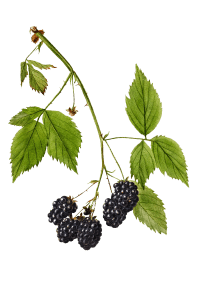
As I did my research into herbs in 2011, I remember thinking how interesting it was that so many of the things we have around all the time were so useful. Mostly, we either think of blackberry as a jam or a nasty bother but it is actually a very beneficial medicinal plant. Blackberry is high in tannins which are very helpful and known as antioxidants but if taken in extremely high doses, it can be linked with cancer. This fact is true of many of the herbs and plants we use to heal and we mostly avoid extremely high doses and concentration for long periods of time.
High-dose tannins can cause problems with the stomach lining and in some cases lead to cancer. In England, there is a much lower rate of this occurrence as opposed to Asia. Both countries drink large amounts of tea. This was investigated in the 30s and it was found that milk neutralizes the tannins in tea. This means if there is any question about the type or strength of tannins in any herb you wish to use, add a little milk to neutralize the tannins.
Caution: People with gastrointestinal disorders should not use the root but can use the leaves and berries with milk or in cooking.
CONSTITUANTS OF BLACKBERRY
CONTAINS: Phenolic compounds that produce acids that help produce glucose in the body, Saponins that help reduce cholesterol absorption, Rutin, a flavonoid, that may also have liver-protecting actions, vitamins, A, C, & K, magnesium and potassium, iron, calcium, riboflavin, niacin, and thiamine
ACTIONS: Antioxidant, astringent, depurative, vulnerary, diuretic, tonic, anti-diabetic, anti-emetic, antiseptic, antifungal, antispasmodic for the uterus.
USES: Anemia, cholera, bleeding gums, flu, cold, calms excessive menstrual bleeding, vomiting, wounds, mouth sores, sore throat, gout, kidney problems, minor burns, fever, ulcers, TB, hemorrhoids, gonorrhea, vaginal discharge, cough, skin rash, to treat thrush and fungal infection. Blackberry leaves can be used topically to treat acne, scars, and stretch marks in a poultice.
 Native Americans obtained fiber from the stems to make strong twine and would enhance the effectiveness of the herb by fermenting the leaves prior to use. To ferment the leaves, slightly bruise wilted leaves with a rolling pin, then wrap them in a damp cloth and hang them in a warm damp place like a bathroom or kitchen. After two or three days, they will begin to smell like roses. This is when you remove them from the cloth and let them dry before using.
Native Americans obtained fiber from the stems to make strong twine and would enhance the effectiveness of the herb by fermenting the leaves prior to use. To ferment the leaves, slightly bruise wilted leaves with a rolling pin, then wrap them in a damp cloth and hang them in a warm damp place like a bathroom or kitchen. After two or three days, they will begin to smell like roses. This is when you remove them from the cloth and let them dry before using.
Young edible shoots are gathered in the spring and once peeled, can be added to salads to get most of the nutrients and carbohydrates from the plant. These carbohydrates are especially helpful after a cold, lean winter.
Boiling down the shoots or making a decoction of the root and leaves works best for a gargle or mouthwash and will also combat severe cases of diarrhea because of the increase in tannins boiling causes. Chewing the leaves releases the astringent tannins and can heal mouth sores and bleeding gums.
To treat inflamed or oozing rashes, make a poultice from a strong decoction of root and leaves then soak a cotton cloth in it. Wring out some then cover the affected area for 30 minutes. This can be repeated several times a day. Blackberry, when the leaves are used as a tea, can dry up sinus drainage. An infusion of Unripe berries is highly esteemed for curing vomiting or loose bowels. The Chinese believe that the fruit increases the Yin and gives vigor to the whole body.
INFUSTION (Tea): Use 2-3 teaspoons of dried leaves per cup of boiling water and steep for 10-20 minutes. If using several times, a day, use 1 teaspoon of blackberry leaves and drink twice a day. 1-2 teaspoons of dried powdered bark may be substituted for an infusion.
DECOCTION: Use 1 teaspoon of powdered root per cup of water boil 30 min, 1 cup per day for up to 5 days.
If using fresh root, chop and peel, crush root slightly, and place peels and root in water boil for 15 minutes. This decoction will be stronger so only use it for 3 days.
Tea for colds: 1oz of blackberry leaves, 1 oz of elderflowers, 1 oz of linden flowers, 1 oz of peppermint leaves. This tea can be used for up to one week.
Cough Syrup: 3 cups of berries, 1 cup of water, 1 tablespoons of dried peppermint or mint, 2 ½ cups honey. Place berries, water, and peppermint in a pan and boil for 10 minutes, strain into a jar, add honey, and mix well. Store in refrigerator. Will last a long time and the water can be replaced with brandy or other alcohol such as burgundy wine.
MAGIC: Gender- feminine, Planet- Venus, Element- water, Deity- Brigit
POWERS: Healing, money, and protection
RITUAL USES: Blackberry was considered to be sacred to some of the old Pagan deities of Europe and was used in worship. To the present day, blackberry pies are baked on Lughnasadh by some Wiccans in commemoration of the harvest, seen poetically as the death of the God.
FOLKLORE: A bramble bush that forms an arch is a great aid to magical healing. On a sunny day, crawl backwards through the arch and then forwards three times, going east to west if possible. This will cause boils, rheumatism, whooping cough, and even blackheads to disappear.
The blackberry leaves are used in spells of wealth as are the berries themselves. The blackberry plant is also used to heal scalds by dipping nine leaves in spring water and then laying them against the wound gently, while saying the following chant three times to each leaf ( 27 times in all): “Three ladies came from the east, one with fire and two with frost, out with fire, in with frost.” (This is an old invocation to the Goddess, Brigit.)
Somewhere in my old memories, I am reminded that the blackberry vines were used on the altar in Ostara rituals to represent the protective home of the rabbit and that maidens would wear the vines in a crown as a symbol of protection and strength. Perhaps this is where the “crown of thorns” concept came from in Christianity.
In Sussex, the 10th of October is fixed as the limit of blackberrying and they say that the devil then goes around the country and spits on the brambles. Note that the 10th of October is old Michaelmas day from the Rev. Friend’s records of English country superstitions. This is the alleged day that Archangel Micheal threw Lucifer from the heavens.
Blackberries were used for a cure in many eras. The cured gout in Greece and Rome and boils in Cornwall.
It is said that all the venom of the devil’s making is vented on the blackberry because on Old Michaelmas Day when he was thrown out of heaven, he landed on a blackberry stand to his great discomfort. Ever since this day, he has spit on the berries and rendered them impossible to pick. I am sure this little bit of folklore was created because of how difficult blackberries are to pick and to manage.
The blackberry bushes were used for many cures in spite of the Devil’s curse. Bramble arches were formed and were the medium for cures like the one to cure boils.
Sick children and cattle passed under the arch too. If it was a child, he was given bread and butter to eat as he lay under the arch of blackberry, while elders repeated the Lord’s Prayer. Additional food was given to a bird or animal as the company journeyed home. If the animal who received this died, it was seen as a sign the patient would recover. If one had the whooping cough, the treatment was more stringent and longer. The patient was put under the bush seven times, saying “In bramble, out cough, here I leave the whooping cough.”
So, before you hack a blackberry bush away because it is a troublesome plant, think twice about its uses.
 Cat Gina Cole is a Hereditary Witch and author of Psychic Skills for Magic and Witchcraft (Llewellyn, 2022). She is the founder of The Coven of the Rising Phoenix and Forum Editor for “Green Egg Magazine.” You can reach her at www.catginacole.com.
Cat Gina Cole is a Hereditary Witch and author of Psychic Skills for Magic and Witchcraft (Llewellyn, 2022). She is the founder of The Coven of the Rising Phoenix and Forum Editor for “Green Egg Magazine.” You can reach her at www.catginacole.com.